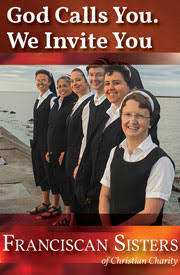Every Catholic knows the feeling. Sometimes the penances bring spiritual progress, sometimes you think you just went through the motions. But when you come out on the other side, it’s Easter all the same, the most beautiful time of the year. There’s a timelessness to all true feasts and human beings around the world have intuitively celebrated them as an opening into eternity. For Christians, Easter is the time when the timeless gave us back a fully renewed eternal destiny.
But let me confess. Easter Monday, when the eternal still lingers about the everyday, seems diminished this year. The abuse crisis has taken its toll on us all. Even Pope Benedict’s letter to Ireland observed that it has obscured the Gospel there more than “centuries of persecution.”
Still, maybe it’s a good thing. The Apostles, whatever joy they felt at the Resurrection, must have been still smarting from betraying Jesus, the traitor Judas in their very midst, and the ongoing threats of religious and secular powers. This year we may be re-experiencing an often forgotten dimension of the first Easter.
Last week, I started writing a letter to the ombudsman of the New York Times spelling out its journalistic misdeeds. If you have followed the controversies, you know that the current round began with claims by the Times that Benedict XVI (as Cardinal Ratzinger) had failed to move to defrock a Wisconsin priest. In fact, when Rome got the case, it was handled by Ratzinger’s deputy, Tarcisio Bertone, in a fairly straightforward way, far quicker than most U. S. murder trials.
Fr. Thomas Brundage, the canon lawyer then responsible for the case has written a public letter stating that: “the reporting on this issue has been inaccurate and poor in terms of the facts. . . .The fact that I presided over this trial and have never once been contacted by any news organization for comment speaks for itself.” About Ratzinger: “I have no reason to believe that he was involved at all. Placing this matter at his doorstep is a huge leap of logic and information.”
The Times later ran a kind of retraction claiming it never actually quoted Fr. Brundage, without making clear that the initial story had proved bogus. By that point, it didn’t much matter. Even conservative sources like Fox News – and local news outlets – were speculating about whether Benedict should resign for “shielding” abusers, either over Wisconsin or a similarly misconstrued case while he was archbishop of Munich.
To me, this is an obvious case of journalistic bias and a scandalous irresponsibility that generated global slanders. No less experienced a journalist than Peggy Noonan has claimed that for the liberal news media – indeed, especially them – the bishops’ failures were not really on the radar until dissident Catholics pushed the case. Noonan argues that even the Boston Globe stories that uncovered the pattern of abuse in America actually helped the Church in ferreting out a nasty institutional problem that might otherwise have never been fixed.
And she’s not alone. An intelligent and orthodox convert has tried to convince me that we have to stop calling John Paul II “the Great,” because he failed to deal with this enormity. I disagree. JPII was great in so many ways that a lapse in governance cannot eclipse his many virtues. And pace Noonan, you’d have to be blind not to see naked anti-Catholic malice abroad. Yet when even some orthodox Catholics are feeling this way, we cannot – and should not – chalk it all up to bias, or the greed of tort lawyers.
There was plenty of both, and worse. The ever loathsome Richard Dawkins expressed the hate that dare not speak its name: “Pope Ratzinger should not resign. He should remain in charge of the whole rotten edifice – the whole profiteering, woman-fearing, guilt-gorging, truth-hating, child-raping institution – while it tumbles amid a stench of incense and a rain of tourist-kitsch sacred hearts and preposterously crowned virgins, about his ears.” For some reason, the otherwise sober Washington Post thought that vileness deserved quoting.
This “scientist” sells millions of books, but allegedly good secularists who accept his critique of religious faith make little effort to distance themselves from his naked hatred. From the women’s auxiliary, the NYT’s Maureen Dowd delivered even worse vitriol without the scientific credentials. We can be sure there are many other sympathizers invisibly active at crucial media and cultural switching points, and we have to be tireless in pointing out what this really has become: open anti-Catholic propaganda.
The U. S. Church cares for one sixth of all hospital patients and subsidizes American cities by educating millions of school children. Internationally, it’s the largest provider of relief and development services. Millions of lives have been saved or improved by the vast numbers of priests, religious, and lay people who perform such service faithfully and quietly every day. The anti-Catholics never mention these large realities.
But they are right about one thing. The Church does have a global problem – one that Rome can help with, but cannot solve by itself. The American bishops took things in hand in 2002 (building on existing measures). Indeed, the late Cardinal Dulles objected at the Dallas meeting that instituted harsh guidelines that they could become unfair and even un-Christian, which has sometimes proved true. Bishops in other countries are just starting, but will find solutions of their own.
Benedict has decreed a year-long penitential period for Ireland. We have to accept that it may take even longer for that country and the rest of the Catholic world to clean up what Benedict himself, just before he was elected pope, denounced: “How much filth there is in the church, and even among those who, in the priesthood, ought to belong entirely to [Christ].”
But we’ve already made a good beginning under his leadership. Catholics and others of good will now must accept another challenge: to expose the open hatemongers for what they are – and make sure they do not prevail.















